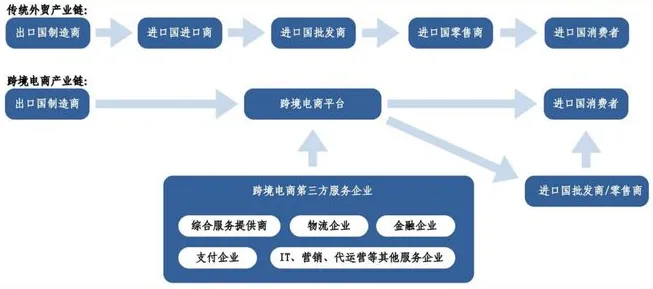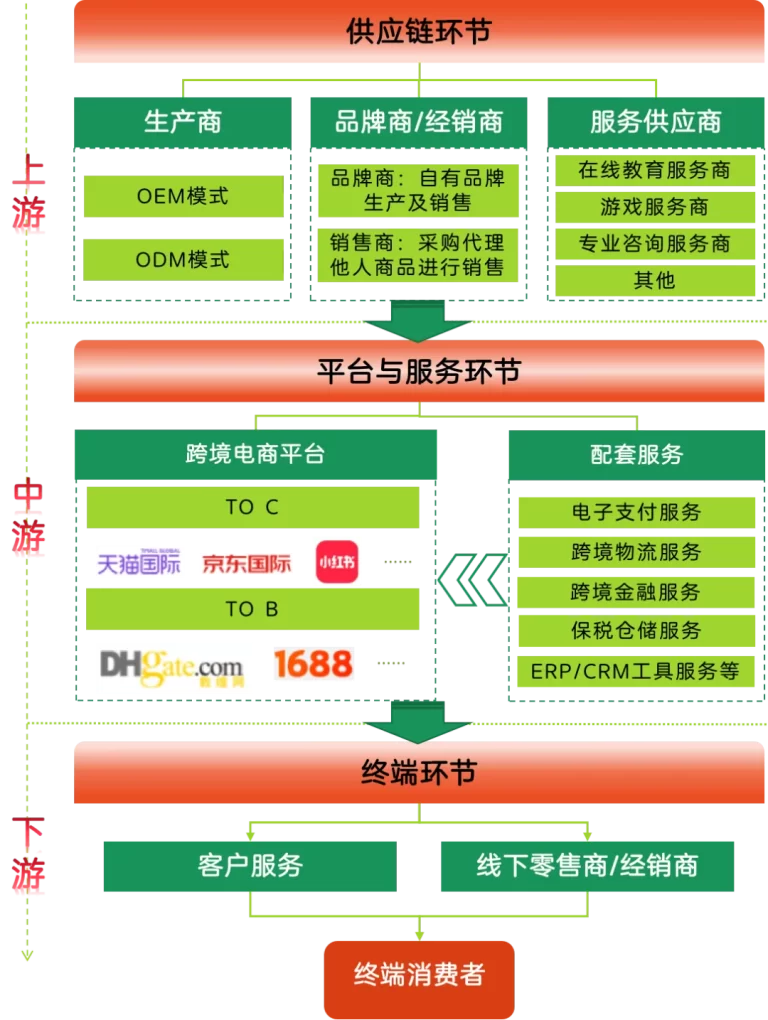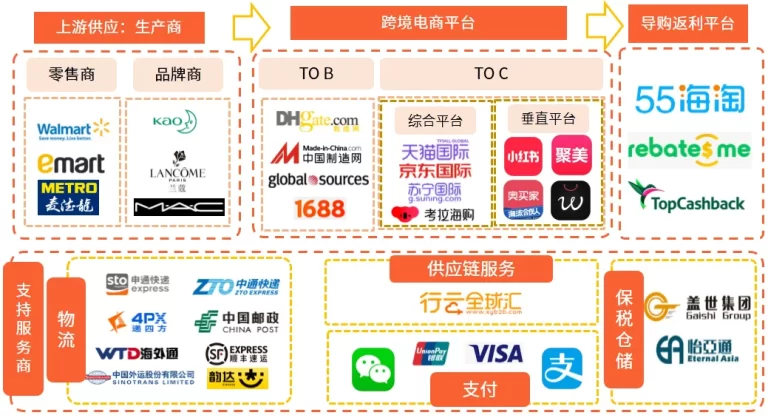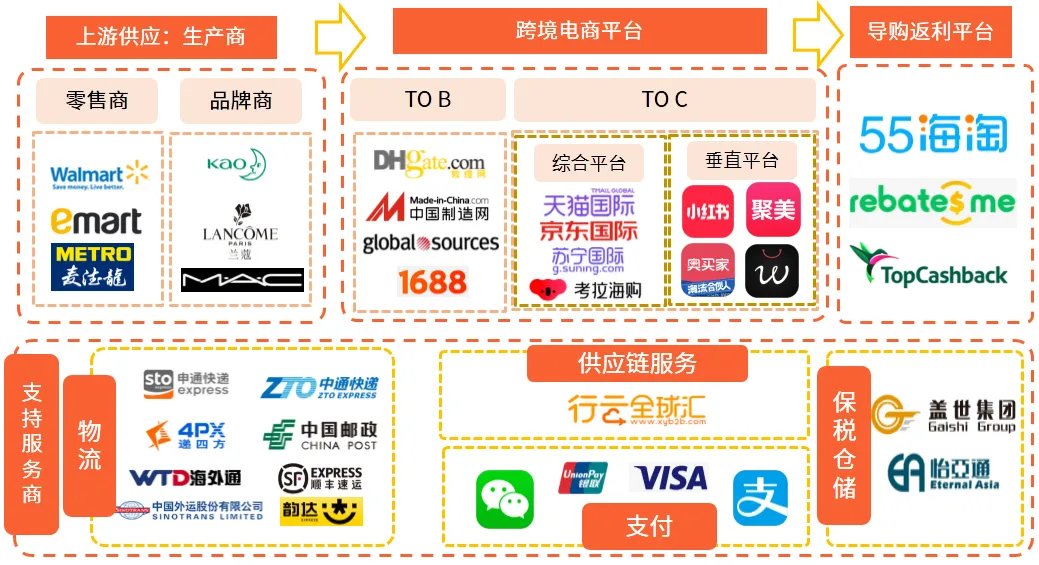01
What is the cross-border e-commerce industry?
Cross-border e-commerce, or “cross-border electronic commerce,” refers to international commercial activities in which trading entities located in different customs territories complete transactions through e-commerce platforms, conduct electronic payment settlements, and deliver goods through cross-border e-commerce logistics and remote warehousing.
To understand “cross-border e-commerce,” we first need to briefly understand what “e-commerce” is:
Broadly speaking, e-commerce, derived from the word “electronic business,” refers to commercial transactions conducted through electronic means. It encompasses both the electronicization of business processes between businesses and the electronicization of internal production management systems.
In a narrower sense, e-commerce (EC) refers to commercial trade activities conducted globally through the use of electronic tools such as the internet (including telegraph, telephone, radio, television, fax, computers, computer networks, and mobile communications).
Currently, it primarily refers to various trade activities conducted over computer networks, involving a wide range of participants, including providers of goods and services, advertisers, consumers, intermediaries, and others. Further focusing on the “industry”, “cross-border e-commerce industry” refers to the collection of companies engaged in cross-border e-commerce business, mainly including commodity or service suppliers, cross-border e-commerce platform companies, electronic payment companies, cross-border logistics companies, customs clearance and inspection agents, after-sales service companies and consulting and other support service companies.

02
Industry Classification Standards
According to the National Bureau of Statistics’ current classification standards and industry practices, cross-border e-commerce has not yet been classified as a separate industry category.
In the National Economic Industry Classification (GB/T 4754), the core business models of cross-border e-commerce (B2B/B2C) are categorized as “Wholesale and Retail” or “Information Transmission, Software, and Information Technology Services,” respectively.
For example, B2B models (such as Alibaba International Station) are included in “Wholesale” (code 51), focusing on supply chain integration and bulk transactions;
B2C models (such as Amazon and AliExpress) are included in “Retail” (code 52) or “Internet Retail” (code 5292), emphasizing end-consumer services.
In my country’s customs statistics system, specific regulatory codes are used to distinguish between cross-border e-commerce trade forms:
Code 1210 is bonded cross-border e-commerce trade, used for bonded warehouse inventory models, such as Tmall Global;
Code 9610 is cross-border e-commerce trade, primarily for direct mail models, such as individual overseas purchases.
However, these codes are used only for trade data statistics and do not contribute to industry classification. In the United Nations’ ISIC (International Standard Industrial Classification) classification, cross-border e-commerce activities are scattered within “Retail” (G47) or “Information Services” (J63), without a separate category.
In my country’s statistical practice, the cross-border e-commerce industry chain is segmented: platform operations are classified as “Information Services,” logistics are included in “Transportation, Warehousing, and Postal Services” (G59-60), and payment and settlement are included in “Financial Services” (J69). Each link in the industry chain is scattered across different sectors.
However, in local statistical practice, some cities, such as Hangzhou and Shenzhen, have added a special section on “cross-border e-commerce” to their statistical yearbooks, but this has not yet been standardized at the national level.
Thus, current statistical standards do not provide a clear industry definition for cross-border e-commerce. Instead, the “cross-border e-commerce industry” is considered a complex industry that conducts cross-border trade activities through e-commerce platforms. Its statistical classification is centered on the business model, and each is incorporated into the existing industry classification system. A separate industry category has not yet been established.
03
Overview of the Industry Chain

The upstream industry primarily encompasses the supply of physical and virtual products, as well as product selection (for retailers).
The product supply chain is the foundation of cross-border e-commerce. Leveraging China’s manufacturing strengths and service industry upgrades, it encompasses premium categories such as apparel, consumer electronics, home furnishings, and digital content.
Product selection and market analysis involve brands and distributors, primarily utilizing boutique brands (such as Anker and DJI) and general distribution models (such as early Amazon sellers), tailoring product selection to international market demand.
The midstream industry, the core component, encompasses platform operations, marketing and promotion, logistics, warehousing, and delivery, payment and financial services, and more.
On the platform side, there are integrated platforms (such as Tmall Global and JD Global), vertical platforms (such as Xiaohongshu), and emerging models (such as independent websites and live-streaming e-commerce).
Supporting services include electronic payment, cross-border logistics, marketing and promotion, and more. Marketing and promotion encompass SEO, social media advertising, and KOL collaborations;
Logistics and warehousing services include postal parcels, commercial express delivery, overseas warehouses (such as Amazon FBA), and emerging logistics models (such as the China-Europe Express);
Payment and finance encompass cross-border payments (such as PayPal), supply chain finance, and foreign exchange management.
Downstream sectors primarily include customer after-sales service, offline retailers, and distributors.
Customer after-sales service includes services such as returns and exchanges, multilingual support, legal dispute resolution, and data privacy compliance.
In addition, extended service industries such as data analysis and technical support (including user behavior analysis, ERP systems, and AI algorithms) should also be considered downstream industries within cross-border e-commerce.
This is because these businesses are all based on cross-border e-commerce.
04
Overview of the Industry Chain

The upstream sector of cross-border e-commerce provides goods for the entire industry chain, representing a vast array of companies. The figure only briefly illustrates these examples.
The midstream of cross-border e-commerce, centered around cross-border e-commerce platforms, is categorized into two main segments: business-to-business (B2B) (e.g., Alibaba International Station, DHgate.com) and consumer-to-consumer (B2C) (e.g., Tmall Global, JD.com International).
Shopping guide and rebate platforms, such as rebatesme and TopCashback, are considered the downstream segment of the cross-border e-commerce industry chain, providing shopping guidance and discounts.
Representative companies providing support services within the cross-border e-commerce industry chain include:
Logistics providers such as STO Express and SF Express, responsible for international transportation and delivery of goods;
Supply chain services such as Xingyun Global Exchange, providing supply chain integration services;
Payment services such as UnionPay and VISA, ensuring the security of funds for cross-border transactions;
Bonded warehousing services such as Gaishi Group and Eternal Asia, providing not only storage but also customs clearance services.
05
Categories of Cross-Border E-Commerce
Based on the nature of the transaction partners, cross-border e-commerce platforms can be categorized into three types: B2B, B2C, and C2C.
B2B is the mainstream form of foreign trade, accounting for approximately 70%.
B2B platforms such as Huangwang and Alibaba International Station are representative B2B platforms, while Tmall Global and JD.com represent B2C platforms, and AliExpress and eBay represent C2C platforms.
Based on the operating entity, platforms can be categorized as platform-based, self-operated, and hybrid (platform + self-operated). Platform-based e-commerce platforms primarily derive revenue from commissions and advertising fees, while self-operated e-commerce platforms profit from the spread between the buy and sell prices of products.
In the platform-based transaction model, brands and platforms are separate, with the platform primarily fulfilling the transaction matchmaking function.
Sellers connect with consumers through e-commerce platforms, are responsible for sourcing or production, and complete sales through the platform. Logistics is handled by the merchant or the platform’s own logistics.
In the self-operated model, brands own independent platforms, have greater control over trade flows, and can respond promptly to market trends. This model is particularly suitable for high-turnover, non-standard products, such as fast fashion. Another model involves logistics distribution, where a logistics provider performs procurement, distribution, and warehousing functions, integrating multiple front-end and back-end business flows of similar types.
This model is particularly suitable for standard products with a high SKU (smallest stock keeping unit) count, such as white-label products like daily necessities, as it creates economies of scale and price advantages.
06
Industry Status and Outlook
The global cross-border e-commerce industry is booming, with the market size projected to exceed $4.8 trillion by 2025.
China, a core engine of global cross-border e-commerce development, saw cross-border e-commerce import and export volume reach 2.63 trillion yuan in 2024, a year-on-year increase of 10.8%.
Currently, my country boasts over 120,000 cross-border e-commerce entities, over 1,000 cross-border e-commerce industrial parks, and 165 comprehensive pilot zones, creating a landscape of concentrated growth in the eastern region and the rise of central and western China.
my country’s cross-border e-commerce policies continue to yield positive benefits. Since 2014, my country has included “cross-border e-commerce” in its government work reports for 11 consecutive years.
At the same time, the future development of my country’s cross-border e-commerce industry faces significant challenges, such as tightening EU tax compliance and fluctuating US tariffs. However, with the deepening application of technologies like AI and blockchain, technological innovation will also drive the reshaping of the industry ecosystem.
Comments ( 2 )
Comments are closed.


Est pellentesque elit ullamcorper dignissim cras. Pulvinar neque laoreet suspendisse interdum consectetur libero id faucibus. Aenean sed adipiscing diam donec adipiscing tristique risus nec feugiat.
At lectus urna duis convallis convallis tellus. Purus in mollis nunc sed id semper risus in hendrerit. Vitae et leo duis ut diam quam nulla porttitor. Porta nibh venenatis cras sed felis eget.